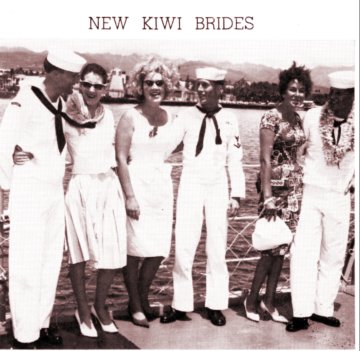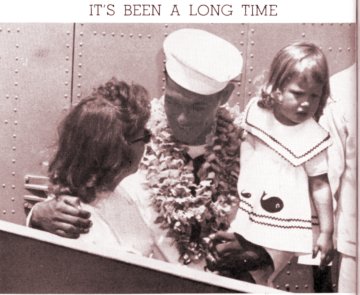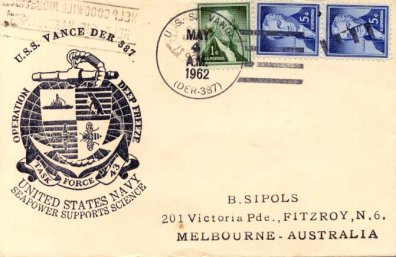Picture df351
 New Kiwi Brides New Kiwi Brides
 Bridge top Bridge top

Picture df352
 It's been a long time It's been a long time
 Bridge top Bridge top

Picture df353
 The binding of the Cruise Book The binding of the Cruise Book
 USS VANCE 61 - 62 USS VANCE 61 - 62
 Bridge top Bridge top

Picture df354
 The History of U.S.S. VANCE from the cruise book The History of U.S.S. VANCE from the cruise book
THE HISTORY OF U.S.S. VANCE
 The U.S.S. Vance was named in honour of Lieut. (jg) Joseph William Vance, jun., U.S.N.R. (1918-1943), who was on
liaison duty with the British Navy when he died at his battle station as a result of injuries received in action and went down
with H.M.A.S. Canberra off Savo Island. His wife, Mrs J. W. Vance, sponsored the ship at its launching.
U.S.S. Vance was built as a destroyer escort by the Brown Shipbuilding Company, Houston, Texas, and was first commissioned on November 1, 1943. After her shakedown she became the flagship of Escort Squadron 45, a group of D.E.s
manned by Coast Guard personnel. The U.S.S. Vance was named in honour of Lieut. (jg) Joseph William Vance, jun., U.S.N.R. (1918-1943), who was on
liaison duty with the British Navy when he died at his battle station as a result of injuries received in action and went down
with H.M.A.S. Canberra off Savo Island. His wife, Mrs J. W. Vance, sponsored the ship at its launching.
U.S.S. Vance was built as a destroyer escort by the Brown Shipbuilding Company, Houston, Texas, and was first commissioned on November 1, 1943. After her shakedown she became the flagship of Escort Squadron 45, a group of D.E.s
manned by Coast Guard personnel.
 During World War II. U.S.S. Vance was engaged in escorting trans-Atlantic convoys. With two exceptions her work was routine. On May 14. 1944, off Oran, Algeria, she participated in the sinking of a German submarine which had succeeded
in torpedoing, but not sinking two merchant ships of Vance's convoy.
A year later, on May Il, 1945, when Vance was escorting a convoy off the Azores, a light was sighted in the convoy. Vance approached at full speed, illuminated the target
with searchlights, and after a few convincing orders in German over the bull horn, the surfaced U-873 surrendered A prize
crew from the Vance, headed by Lieut. C. J. Schmidt, U.S.C.G.R., boarded the U-boat and it was escorted safely back to
Portsmouth, N.H. During World War II. U.S.S. Vance was engaged in escorting trans-Atlantic convoys. With two exceptions her work was routine. On May 14. 1944, off Oran, Algeria, she participated in the sinking of a German submarine which had succeeded
in torpedoing, but not sinking two merchant ships of Vance's convoy.
A year later, on May Il, 1945, when Vance was escorting a convoy off the Azores, a light was sighted in the convoy. Vance approached at full speed, illuminated the target
with searchlights, and after a few convincing orders in German over the bull horn, the surfaced U-873 surrendered A prize
crew from the Vance, headed by Lieut. C. J. Schmidt, U.S.C.G.R., boarded the U-boat and it was escorted safely back to
Portsmouth, N.H.
 Subsequent to V.E. Day, Vance was ordered to the Pacific theatre, but arrived too late to participate in other than
training exercises. She was placed in mothballs with the inactive fleet at Green Cove Springs, Florida, in November, 1945,
[# as printed; does not include USCGC VANCE as WDE487 in 1952 - 1954] and brought to Mare Island naval shipyard for conversion to a D.E.R. in November, 1955. The conversion was an extensive one, involving the addition of much new electronics equipment. Improved air and surface-search radar, a height
finding set, and extensive communications equipment made up the new main battery of the ship. Complete facilities for
the operational control oi interceptor aircrait were also included. Ordnance was modernised wiih upto-date additions and
modifications. Loss of Living space resulting from increased equipment installations required the enclosing of the entire main
deck amidships section to provide necessary berthing and messing spaces. An extensive programme of habitability improvements made Vance one of the most "liveable" ships in the fleet. The ship proceeded in March, 1957, to her new home port
of Seattle, Washington, where she reported for duty with Escort Squadron 5. Subsequent to V.E. Day, Vance was ordered to the Pacific theatre, but arrived too late to participate in other than
training exercises. She was placed in mothballs with the inactive fleet at Green Cove Springs, Florida, in November, 1945,
[# as printed; does not include USCGC VANCE as WDE487 in 1952 - 1954] and brought to Mare Island naval shipyard for conversion to a D.E.R. in November, 1955. The conversion was an extensive one, involving the addition of much new electronics equipment. Improved air and surface-search radar, a height
finding set, and extensive communications equipment made up the new main battery of the ship. Complete facilities for
the operational control oi interceptor aircrait were also included. Ordnance was modernised wiih upto-date additions and
modifications. Loss of Living space resulting from increased equipment installations required the enclosing of the entire main
deck amidships section to provide necessary berthing and messing spaces. An extensive programme of habitability improvements made Vance one of the most "liveable" ships in the fleet. The ship proceeded in March, 1957, to her new home port
of Seattle, Washington, where she reported for duty with Escort Squadron 5.
 Between March, 1957 and June, 1958, Vance completed 12 patrols on various stations of the radar early warning
system in the North Pacific, While on picket duty she and her sister ships maintained a round-the-clock vigil with their
air-search radar, tracking and reporting every aircraft leaving or approaching the coast of the North-western United States
in order to prevent any air-borne attack from reaching our shores without warning. One of these patrols was noteworthy
in that the Vance set something of a record in getting under way. On Labour Day, in the midst of a three-day weekend
holiday, the ship was notified that one of the vessels on station had suffered a disabling engineering casualty requiring
her immediate relief. Hastily summoning those personnel who could be reached ashore, Vance cleared her berth one
hour and a quarter after receipt of her orders, and successfully completed a 12-day picket patrol with only 60 per cent.
of her officers and men aboard. In this "can-do" spirit, Vance and her eight sisters of Cortron 5 are continuing to maintain their ceaseless vigil to help guard our shores from air-borne attack. Between March, 1957 and June, 1958, Vance completed 12 patrols on various stations of the radar early warning
system in the North Pacific, While on picket duty she and her sister ships maintained a round-the-clock vigil with their
air-search radar, tracking and reporting every aircraft leaving or approaching the coast of the North-western United States
in order to prevent any air-borne attack from reaching our shores without warning. One of these patrols was noteworthy
in that the Vance set something of a record in getting under way. On Labour Day, in the midst of a three-day weekend
holiday, the ship was notified that one of the vessels on station had suffered a disabling engineering casualty requiring
her immediate relief. Hastily summoning those personnel who could be reached ashore, Vance cleared her berth one
hour and a quarter after receipt of her orders, and successfully completed a 12-day picket patrol with only 60 per cent.
of her officers and men aboard. In this "can-do" spirit, Vance and her eight sisters of Cortron 5 are continuing to maintain their ceaseless vigil to help guard our shores from air-borne attack.
 On June 1, 1958, the home port of the Vance was changed from Seattle, Washington, to Pearl Harbour, T.H. One month later she leit for a 29-day patrol on the new Mid-ocean-line which provides radar coverage from Alaska to Midway
Island. This was a historic event as several years of planning went in to the formation of this extension of the Dew
(Distant Early Warning) Line in the Pacific, and the Vance was the first ship to sail under the newly-organised Pacific Barrier Patrol. On June 1, 1958, the home port of the Vance was changed from Seattle, Washington, to Pearl Harbour, T.H. One month later she leit for a 29-day patrol on the new Mid-ocean-line which provides radar coverage from Alaska to Midway
Island. This was a historic event as several years of planning went in to the formation of this extension of the Dew
(Distant Early Warning) Line in the Pacific, and the Vance was the first ship to sail under the newly-organised Pacific Barrier Patrol.
 On several occasions she was detached from her regular duties on station to take under surveillance Russian trawlers equipped as electronics intelligence vessels and often discovered more of Russian electronics capability than they did of hers.
From February until May of 1961, Vance underwent a regular shipyard overhaul at Pearl Harbour naval shipyard.
After a refresher training period, Vance returned to her regular Navaid/Sar duties on the Dew Line. Shortly thereafter
she received orders to report to Commander Task Force 43 to act as ocean station vessel in Operation Deepfreeze 62. On several occasions she was detached from her regular duties on station to take under surveillance Russian trawlers equipped as electronics intelligence vessels and often discovered more of Russian electronics capability than they did of hers.
From February until May of 1961, Vance underwent a regular shipyard overhaul at Pearl Harbour naval shipyard.
After a refresher training period, Vance returned to her regular Navaid/Sar duties on the Dew Line. Shortly thereafter
she received orders to report to Commander Task Force 43 to act as ocean station vessel in Operation Deepfreeze 62.
Picture df355
 Post Mark Found on aspen-ridge.net/ Post Mark Found on aspen-ridge.net/
 Bridge top Bridge top

|



 New Kiwi Brides
New Kiwi Brides Bridge top
Bridge top

 It's been a long time
It's been a long time Bridge top
Bridge top

 The binding of the Cruise Book
The binding of the Cruise Book USS VANCE 61 - 62
USS VANCE 61 - 62 Bridge top
Bridge top

 The History of U.S.S. VANCE from the cruise book
The History of U.S.S. VANCE from the cruise book The U.S.S. Vance was named in honour of Lieut. (jg) Joseph William Vance, jun., U.S.N.R. (1918-1943), who was on
liaison duty with the British Navy when he died at his battle station as a result of injuries received in action and went down
with H.M.A.S. Canberra off Savo Island. His wife, Mrs J. W. Vance, sponsored the ship at its launching.
U.S.S. Vance was built as a destroyer escort by the Brown Shipbuilding Company, Houston, Texas, and was first commissioned on November 1, 1943. After her shakedown she became the flagship of Escort Squadron 45, a group of D.E.s
manned by Coast Guard personnel.
The U.S.S. Vance was named in honour of Lieut. (jg) Joseph William Vance, jun., U.S.N.R. (1918-1943), who was on
liaison duty with the British Navy when he died at his battle station as a result of injuries received in action and went down
with H.M.A.S. Canberra off Savo Island. His wife, Mrs J. W. Vance, sponsored the ship at its launching.
U.S.S. Vance was built as a destroyer escort by the Brown Shipbuilding Company, Houston, Texas, and was first commissioned on November 1, 1943. After her shakedown she became the flagship of Escort Squadron 45, a group of D.E.s
manned by Coast Guard personnel. Post Mark Found on aspen-ridge.net/
Post Mark Found on aspen-ridge.net/ Bridge top
Bridge top
